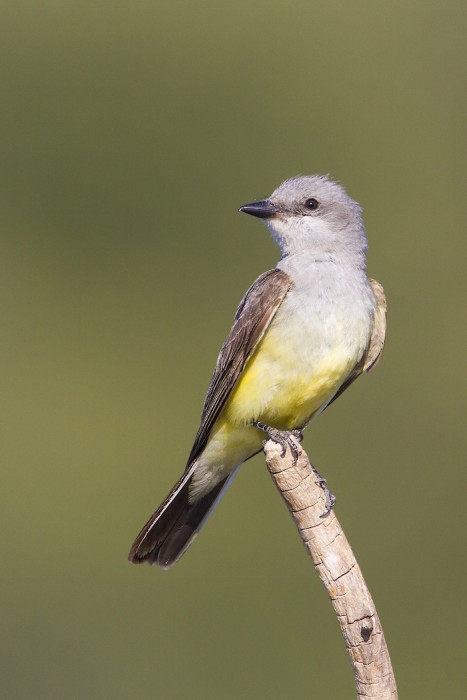
Most birds are more sensible. They gather their food from the ground, or leaves, or something solid, or at least liquid! But flycatchers make a living on the wing, plucking insects—not necessarily flies—right out of the air.
The flycatchers are a large group of birds that thrive in many habitats. Some are small, greenish, and tucked in close to riparian brush. Some hunt in woodlands or forest canopies. Some flash brightly along open fields.
But all of them share their hunting behavior. They scan from a perch, fly out in pursuit of an aerial insect, and, with any luck, snatch the bug with their beak and return to a perch to dine. If you see a bird fly out, squiggle in the air, and return to a post or prominent branch, you are almost certainly watching flycatching.
Our largest flycatcher, the western kingbird, is frequently seen on roadside fence-wires. The fences make perfect perches from which to hunt over the fields they prefer. A nearby oak or telephone pole will provide a nesting site, and the kingbirds are good to go!
Not shy at all, western kingbirds decorate their neighborhoods with bright flashes of color from their lemon-yellow bellies, and loud, rubber-ducky chattering. They will tolerate nearby nests of what they judge as gentler birds, such as robins and doves, but aggressively harass hawks, owls, and nest predators such as ravens, crows, and magpies. While defending their nesting territories, kingbirds may become aroused, causing their head feathers to stand erect and revealing the crimson crown that is normally completely hidden but earns the kingbird its name.
Like other flycatchers, kingbirds must be strong flyers. To support their aerobatics, they have a keeled breastbone—picture a fin of bone extending out from your breastbone. This structure allows the strong muscles that move the wings to anchor farther forward, giving them better leverage for power and agility. A less pronounced version of the keeled breastbone may be seen in your chicken dinner.
Unlike chickens, kingbirds migrate a long way. Most western kingbirds winter in Central America. In March and April they flap a couple thousand miles into the western US or Canada. There they build a nest of soft plant material, usually high in a tree or human construction, and incubate a handful of camo-blotched eggs. The number of eggs per clutch and the number of clutches attempted vary with the abundance of food.
The hatchlings emerge naked in about eighteen days, and set about gaping for food and growing their muscle, bone, and feathers—gray head and back, yellow belly, and black tail with fine white edgings. If all goes well and the nest predators are kept at bay, in just three more weeks a new generation of western kingbirds is ready to try its skill at hunting the bugs that buzz our fields.
